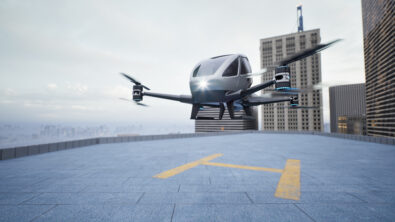Talking Aerospace Today – AI in Aerospace Part One – Summary

With the Talking Aerospace Today podcast finishing its segments on automation in the journey of digital transformation maturity, it will now be covering the futuristic, more advanced stages of the journey. As the previous episode hinted at artificial intelligence (AI) will be playing a significant role in these stages. Since it is such a critical but still new technology, the podcast will first focus on introducing AI and exploring how it can benefit the aerospace and defense (A&D) industry and digital transformation.
In this latest episode, Todd Tuthill, Vice President of the A&D Industry for Siemens Digital Industries Software, is joined by special guest Justin Hodges, AI/ML technical specialist and product manager for Siemens Simcenter. The two of them spent this episode discussing how the potential of AI is different than before, why it is needed in the A&D industry, and ways it can benefit aerospace engineering processes.
AI is here to stay
The concept of AI is nothing new, and this is hardly the first time people have discussed applying it in the real world. Justin acknowledges that every ten years or so, hype about AI experiences a major spike in attention, but it usually fades away. The conversation around it today, however, feels different. Today’s AI seems to have passed the threshold of hype and is now being seen as a legitimate way to improve businesses.
That difference, according to Justin, is due to the significant advancements GPU technology has undergone in the last few years.. The hardware has improved dramatically in the past decade, leading to the production of better GPUs that can operate more sophisticated machine learning models, which can run more advanced, accurate models and handle larger amounts of data to make better predictions.
Why AI?
Some may wonder what place AI could possibly have in the A&D industry, but Todd points back to the industry-wide problem it and the rest of digital transformation maturity could help solve: the workforce shortage.
The A&D industry is working on so many innovative things such as sustainable aviation and commercial space tourism, but there are simply not enough aerospace engineers, technicians, etc. to bring them into reality. AI is another technology companies can utilize to multiply the impact their current workforce and create a better working environment to attract new engineers with.
AI in practice
AI also provides multiple ways to improve engineering processes, such as by making faster and better predictions, as Justin points out. Much of the work that he does at Simcenter focuses on using AI to receive faster insights, and they have made tangible results. By using a company’s stored data, AI can make predictions in a fraction of a second instead of over 30 hours of physical testing and subsequent data processing. In practice, this can allow engineers to discard bad designs and discover good designs faster.
Todd also explains how this ability can help retain knowledge as the workforce changes. One of the drivers behind the worker shortage in A&D is the retirement of many capable, intelligent engineers that have been in the business for decades. While they may be leaving, the incredible amount of data and insights they have made over the years can be stored in a company’s proprietary data lake, which AI can then reuse and learn from to innovate new things based on those engineers’ concepts, rules, and design methodologies.
A revolution for aerospace
AI may be a new, still-growing technology, but it already presents many opportunities to alleviate obstacles the A&D industry is currently facing. With its ability to achieve faster insights and retain knowledge from retiring engineers, it holds great potential to multiply the impact of the engineering workforce and truly revolutionize the way the industry conducts business.
Of course, this is only the beginning of the podcast’s exploration of AI in aerospace. Stay tuned for future episodes on Talking Aerospace Today to learn more ways AI can transform the A&D industry.
Siemens Digital Industries Software helps organizations of all sizes digitally transform using software, hardware and services from the Siemens Xcelerator business platform. Siemens’ software and the comprehensive digital twin enable companies to optimize their design, engineering and manufacturing processes to turn today’s ideas into the sustainable products of the future. From chips to entire systems, from product to process, across all industries. Siemens Digital Industries Software – Accelerating transformation.


